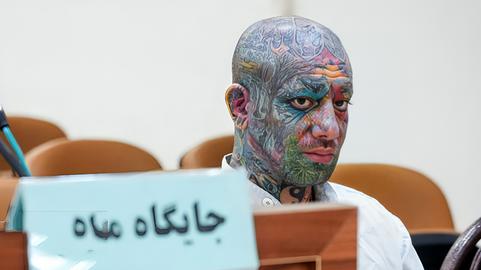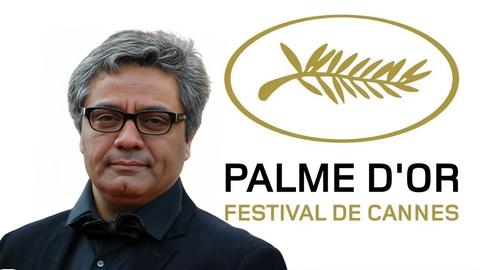Jordan Street, on any given Thursday night in Tehran, is a stage for the city’s youth. Groups of friends cruise up and down in everything from battered Kias to the shiny expensive car of the day, listening to music, flirting at red lights, and watching one another be young and lively. It is also a place where Basijis gather, disapproving of all these goings on, sometimes watching with a glare, sometimes intervening to confiscate a CD, a bottle, a person. After the Iranian Revolution Jordan Street was renamed Africa Street, but in practice, Tehranis have clung to the old name, which honors a man neither the kids with the gelled hair nor the Basijis with the keffiyehs are likely to know anything about: Samuel Jordan of Pennsylvania, the founder of the American College of Tehran, later known as Alborz, the secondary school that was legendary before perhaps any other secondary school in the entire Middle East was worthy of legend.
As an American who showed up in Iran and ended up playing a formative role in the country’s history, Jordan’s memory lives on most vividly through the street that bears his name. But he is not by any means the only one. For the first half of the twentieth century, before the 1953 coup that corroded Iran’s relationship with the United States, a succession of Americans fell in love with Iran. They came as educators and financial advisors and scholars, but shared a profound attachment to the country’s culture and its people. They loved Iran and worked to build it as a nation. These are their stories.
An Emotional Patriot in Tabriz

From an exhibit at the Constitution House of Tabriz: American Howard Baskerville, hero of the Constitutional Revolution, is honored in carpet form
In the early glow of a Tabriz dawn in 1909, Howard Baskerville barked orders to his soldiers, instructing them to get into position and to be courageous in the face of their enemies. As Royalist forces besieged the city, the young American, a 22-year-old more accustomed to the halls of Princeton University than to the battlefield, led his men, by some accounts less than 15, into the fight.
Baskerville had arrived in Tabriz as a Presbyterian missionary and a schoolteacher, but as Iran’s Constitutional Revolution gained force, he took inspiration from the Iranians amongst whom he lived and taught, and decided that staying in the classroom would place him on the coward’s side of history. “He felt that freedom is something everybody is entitled to,” says Houchang Chehabi, professor of history at Boston University, who edited a book on Baskerville.
A student of Woodrow Wilson during his Princeton days, Baskerville had absorbed the future president’s belief in a nation’s right to self-determination. “He starts training his students, contrary to the wishes of the school and the American consul,” Chehabi says. “They hate him for it, they tell him, ‘It’s not your place to get mixed up.’”

Stars and stripes fly over the U.S. consulate in Tabriz during the Constitutional Revolution
Sattar Khan, the leader of the Constitutionalist Rebels in Tabriz, was reportedly also ambivalent about Baskerville’s military ambitions, but Baskerville was unmoved by his opposition. Likely recalling such international icons of the American Revolution as the Marquis de Lafayette, Baskerville said in defense of his commitment, “The only difference between me and these people is the place of my birth, and that is not a big difference.”
In April, Baskerville led a diminished force—for courage had failed many of his fighters by most accounts—on a sortee against the city’s walls. A sniper shot him straight through the heart.
Thus Baskerville enshrined himself in Iranian history as an American martyr, a man so passionate about the cause of Iranian constitutionalism that he gave his life for it. “He had taken a liking to the people he taught, and this American mentality of freedom, the right to representation, and the idea of a majles made him side with the Constitutionalists,” says Touraj Daryaee, a professor of history at the University of California, Irvine.
Sattar Khan himself sent a telegram to Baskerville’s family in Nebraska after the funeral: “Persia much regrets [the] honorable loss of your dear son in the cause of liberty, and we give our [word] that future Persia will always revere his name in her history like Lafayette, and will respect his venerable tomb.” For most of the intervening years, Baskerville’s grave in Tabriz is said to have been covered with yellow flowers. His death even inspired the celebrated poet and scholar Malek ol-Shoar’a Bahar.
Though Baskerville’s sacrifice looms large in the cultural imagination of an older generation of Iranians, “he didn’t have an impact on history,” Chehabi says. His legacy is more striking in its symbolism, its dramatic conveyance that at a time when Iranians were profoundly vulnerable to British and Russian imperial aspirations, an American stepped in, espoused the cause of their independence, and died for it.
The Accountant Who Challenged the Tsar

'How Russia Came to Make War on W. Morgan Shuster', New York Times article, 1911
Less well known in the pantheon of Americans who loved Iran, but far more influential, is Morgan Shuster, whom the majles appointed treasurer general in 1911. Under the Qajars, Iran had accumulated enormous debts to imperial powers, especially Russia, and Shuster quickly understood the chain of complicity that had allowed Qajari royals to flourish along with their foreign patrons. His handling of state finances, along with the reforms he implemented, effectively advanced the Constitutionalist cause. “The British and the Russians weren’t too happy with this guy keeping the ledgers straight,” says Daryaee.
Acting on the parliament’s orders, Shuster seized the assets of the Shah’s brother, Shua al-Saltaneh, who was aligned with Russia’s sphere of interest in Iran. An enraged Russian Empire responded by landing troops on Bandar Abbas, prompting a New York Times article with the lede, “The Thirty-Four-Year-Old American Who Defied the Czar – He Went to Persia to Save Her From Financial Ruin and is Upsetting the International Plot for Her Partition.”
Shuster didn’t stay in Iran long enough to fulfil his objective of securing the country’s finances. At the end of 1911, after only six months, Russia and Britain pushed Iran to expel him, and Shuster retreated to the United States. “Then he writes a scathing book, because he had a grasp of what was happening to these nations in the Middle East, if we use the terminology of today, in the developing world, where superpowers were trying to gain a strong foothold,” says Daryaee. “He too shared this American ideal of liberty and idealistic values.”
His 1912 book, entitled The Strangling of Persia, is an indictment of the destructive role Russia and Britain played in Iran in the early twentieth century, interfering in governance, indirectly siphoning the country’s wealth, and obstructing the Iranians’ efforts to build the institutions necessary for a popular democracy. “It was obvious that the people of Persia deserve much better than what they are getting, that they wanted us to succeed, but it was the British and the Russians who were determined not to let us succeed,” Shuster wrote.
Nearly two decades later, in 1922, another ambitious American, Arthur Millspaugh, picked up Shuster’s unfinished task. “Reza Khan called him in to create the finance ministry, and he instituted a tax system and put the country’s finances on reasonably good footing,” says Chehabi. “This then allowed Reza Shah to finance his state building project.” Millspaugh spent five years on that mission, and returned again in the 1940s for another stint ironing out the country’s finances, encountering some difficulties both times. Although he disagreed with Reza Shah over military spending, and clashed with some high-born parliamentarians who resisted taxation, his efforts in the finance ministry and his work to put in place a taxation system created structures on which the developing Iranian state would come to rely.
Work Together, Play Together

Samuel Jordan
In the early 1900s, Samuel Jordan, an American educator, dismayed many noble families in Tehran when he demanded that their sons start running around a soccer field with the children of middle-class Iranians, the sort of people they would never encounter at dinner parties. “This was not appreciated by some of the parents,” says Chehabi, “but Jordan said, ‘A nation that plays together can work together.’ This had a very equalizing impact, and he tried to give the same treatment to the sons of those aristocrats as he gave to middle-class Iranians.”
This was the same Jordan for whom the street in Tehran was named. Jordan sailed for Iran from New York in 1898, writes the historian Michael Zirinsky of Boise State University, and arrived in Tehran by horse-drawn carriage. Like Baskerville, Jordan was a Presbyterian missionary, and he helped develop his mission’s Boys School in Tehran, and to expand it over the course of the next two decades into a high school and eventually a college.

McCormick Hall, at the American College of Tehran, around 1930
The American College in Tehran, Zirinsky writes, built a reputation as “a factory that made men,” and a place where Jordan’s ethos of equality and teamwork prevailed; some women served as teachers, and students and teachers went hiking together on Mount Damavand, and volunteered in poor rural areas. Before learning cooperation and teamwork through sports became the core approach of modern corporate and MBA programmes across the world, Jordan was applying this ethic in Iran in the 1920s. One colleague from America, recounts Zirinsky, received this telegram from Jordan before setting off from Tehran: “Transportation arranged from the border; bring three dozen footballs.”
Jordan’s school became Alborz College in 1928, and in the late 1930s the Iranian government nationalized the institution as a state high school, but Alborz continued to turn out future ministers, urban planners, and promising scholars, thanks in part to the stewardship of Professor Mohammad Ali Mojtahedi, who took over the school in 1944 and ran it successfully until the revolution.
Although Jordan did all of this work in the name of the Presbyterian cause, the mission had an agreement with the Iranian government that Muslims were off limits for conversion. His vastly ambitious project seemed driven by a vision and a commitment beyond his religion, and more in line with American ideals of education and the promise of social mobility for the hard-working.
Zirinksy, who also attended the Tehran Presbyterian Mission’s Community School as a young person, says “I do not see the American Presbyterian missionaries in Iran as having travelled to make converts to their Church, as what they wrote to their home Churches implied.” Rather he believes that they sought to live lives of Christian service to others. “Everything I have seen about [Jordan] suggests that his work at Alborz was his life,” he says.
Ali Gheissari, a historian at the University of San Diego, writes that the college provided both the physical and cognitive space the country needed for participation in educational reform, and that as such, “it was part of a wider context of modernization with which a broad range of individuals from different social and community backgrounds and generations identified themselves.”
“There are tales of him staying even when he was in a wheelchair, when the students used to move him around the school,” Daryaee says. “He had a very personal loyalty to the place, and it’s because of that these thousands of students and graduates have a very intense relationship with the school.”
The Man Who Sketched Every Mosque

Arthur Pope, American expert on Persian art
As Jordan ran his students around the football field in the mid-1920s, a young art historian and dealer named Arthur Pope arrived in Persia. Pope was a specialist in Persian textiles and architecture, who had taught at universities and served as a consultant to wealthy Americans who collected Persian art. In Iran he gave a speech before Reza Khan, extolling the richness of Iran’s architectural past, impressing the ruler, and initiating a long collaboration between the two. Pope’s influence and his passion for classic Persian architecture encouraged Reza Khan to restore buildings in Isfahan and to commission architectural projects in Tehran, including the city’s Marble Palace and the headquarters for Bank Melli and the Tehran police, both of which referenced Iran’s heritage.
Pope spent most of his time in Iran on ambitious projects. He trekked all around the country photographing monuments and buildings—particularly mosques, which through Reza Khan’s help, he was permitted to enter as a non-Muslim. His towering contribution, though, was his survey of Persian art. “It is simply a monumental work, it’s still the preeminent volume on its subject after six decades,” says Daryaee. “Iran didn’t have anything similar at the time, [and] hasn’t had it yet.”
Pope’s six-volume epic, Daryaee notes, retains the art world nomenclature of its time, “Persian Art,” which recalls at a time when Iranian art still commanded its own identity, rather than being subsumed into “Islamic art” or hovering in the margins of Arab-Islamic art. As Noel Silver writes in his entry on Pope for the Encyclopedia Iranica: “for most of his life he had one pressing desire to which he devoted his prodigious energies: to bring the art of Persia to a larger audience, including the Persians themselves, and to present it in all its magnificence.”
In the 1960s Pope returned to Iran and received from Mohammad Reza Shah the Taj Order and Homayoun Order. The Shah invited Pope to shift his activities to Iran, and Pope moved with his wife to Shiraz, where they established a version of the Asia Institute they had built up in New York, based in Narenjestan Palace. When Pope died in Shiraz at the age of 88 he received a state funeral and was buried in a specially-designed Seljuk-style mausoleum in Isfahan.

Arthur Pope’s Seljuk-style mausoleum in Isfahan
Vandals defaced Pope’s mausoleum in April amid the controversy over the burial of one of his students, Richard Frye, who had asked to be buried near the Zayandeh River in Isfahan. Frye was one of the twentieth century’s most distinguished Iranists, a scholar arguably more prominent and respected in his field than anyone else in the world. His career spanned much of the century and included publication of volumes like The Heritage of Persia. “He dedicates this book to the Iranian people, mentions some of them, the Kurds, the Lors, and others,” says Daryaee. “He presented this Iranian world from Tajikstan to Iran with some real emotion and connection, his interest went beyond simply covering Orientals.”
Frye’s scholarship covered both the period before and after the Islamic conquest of Iran and also encompassed Central Asia. He helped create Harvard University’s Center for Middle Eastern Studies, and invited numerous prominent Iranians like the writer Jalal al-e Ahmad to visit as fellows. A Harvard obituary describes him traveling to the village of Sar Mashhad on a mule, through sandstorms and desert heat to collect a Pahlavi stone inscription from atop a cliff, a discovery that would prove significant although the effort left him very ill. Ali-Akbar Dehkhoda called Frye “Irandust,” lover or friend of Iran, in 1953, and Frye reportedly took such pride in the title that he sometimes used it as an additional surname.
In 2008, explaining why he wished to be buried in Isfahan, he said that “the Iranians are very hospitable people, and I love them very much.” Isfahan, he reasoned, sat at the heart of country. “It is the cultural center of Iran.”
Whether the hardliners who oppose Frye’s burial in Isfahan and denounce him as a spy will succeed in blocking his last wish remains to be seen. But in the graves of Baskerville in Tabriz, and of Pope and his wife in Isfahan, and in the street called Jordan, the legacy of the other Americans who loved Iran lives. Jordan Boulevard will remain the playground of Tehranis’ teenage years, the place where they first received the phone number of a girl, a smile from a handsome young man, a place where it was beautiful to be young and full of hope.






















comments
To Anonymous: Well, I'm American and I don't hate Iran. I am aware of the ignorant people who hate people from another country just because of the origin of their birth. I am not one of those people. I am also aware that there is a difference between a government and its people. There is a lot more to a coun try than its government. Every individual is unique and needs to be taken for who they are, not by what country they are from.
I was deeply affected by the Iran protests in 2009, I followed on Twitter, I longed to help somehow, but barely had any money (recent college grad, with a bad cold, I remember). In the basement, during a nice June day, I was glued to the computer, learning about the passion and courage of Iran's people. I have not lost this ...connection to Iran, although I wish I could do more, learn more, I am separated by an almost insurmountable obstacle.... No way for me to even talk to an Iranian myself, though I wish I could go there someday. I hope our two countries can reconcile and we can collaborate with each other, --with people who love freedom and justice. ... read more
عشق
I was beautiful and young and full of hope in Iran in 1978. I want the youth of Iran and the youth of the U.S.A. to share again in a promising future. Thank you so much for this article today.
"The Americans who Hate Iran" would be a wonderful article, considering the extremely high degree of hatred the American people hold for Iran and its people. One could even write a book about it.